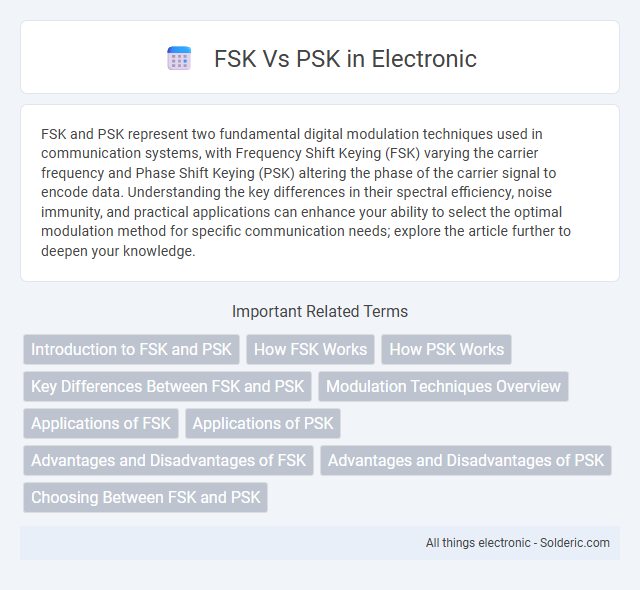FSK and PSK represent two fundamental digital modulation techniques used in communication systems, with Frequency Shift Keying (FSK) varying the carrier frequency and Phase Shift Keying (PSK) altering the phase of the carrier signal to encode data. Understanding the key differences in their spectral efficiency, noise immunity, and practical applications can enhance your ability to select the optimal modulation method for specific communication needs; explore the article further to deepen your knowledge.
Comparison Table
| Feature | FSK (Frequency Shift Keying) | PSK (Phase Shift Keying) |
|---|---|---|
| Modulation Type | Frequency-based | Phase-based |
| Signal Characteristics | Changes frequency to represent data | Changes phase to represent data |
| Bandwidth Efficiency | Lower, wider bandwidth required | Higher, more bandwidth efficient |
| Noise Immunity | Moderate, resistant to noise | Generally better, especially in AWGN channels |
| Complexity | Simple implementation | More complex modulation and demodulation |
| Data Rate | Lower, suitable for low-speed data | Higher, supports higher data rates |
| Common Applications | Telemetry, low-speed modems, RFID | Wi-Fi, Bluetooth, satellite communications |
| Power Efficiency | Moderate | High power efficiency |
Introduction to FSK and PSK
Frequency Shift Keying (FSK) and Phase Shift Keying (PSK) are prominent digital modulation techniques used in communication systems. FSK modulates data by varying the frequency of the carrier signal, making it robust against noise and suitable for low-bandwidth applications. PSK alters the phase of the carrier signal to represent data bits, offering higher spectral efficiency and better performance in high-speed data transmission, which can enhance your communication system's reliability and capacity.
How FSK Works
Frequency Shift Keying (FSK) works by modulating a carrier wave's frequency to represent digital data, using distinct frequencies for binary '0' and '1'. This technique offers robust noise immunity, making it suitable for wireless communication and radio transmission. Your data is encoded by shifting the frequency between two predetermined values, enabling efficient and reliable binary signal transmission.
How PSK Works
Phase Shift Keying (PSK) modulates digital signals by varying the phase of a carrier wave to represent data bits, making it highly efficient for bandwidth usage. In PSK, different phase angles, such as 0deg, 90deg, 180deg, or 270deg, correspond to unique binary patterns, enabling the transmission of multiple bits per symbol. Your communication system benefits from PSK's robustness against noise and improved spectral efficiency compared to Frequency Shift Keying (FSK).
Key Differences Between FSK and PSK
Frequency Shift Keying (FSK) modulates data by varying the frequency of the carrier signal, whereas Phase Shift Keying (PSK) changes the phase of the carrier wave to represent digital information. FSK typically offers better noise immunity and simpler implementation but requires more bandwidth compared to PSK, which provides higher spectral efficiency and faster data transmission. PSK is preferred in high-speed communication systems due to its ability to maintain signal integrity with limited bandwidth.
Modulation Techniques Overview
Frequency Shift Keying (FSK) and Phase Shift Keying (PSK) are fundamental digital modulation techniques used in communication systems to transmit data by varying specific signal properties. FSK changes the carrier wave frequency to represent binary data, making it robust against signal amplitude variations and noise. PSK modifies the phase of the carrier signal to encode information, offering better spectral efficiency and higher data rates, which can significantly enhance your communication system performance depending on channel conditions.
Applications of FSK
Frequency Shift Keying (FSK) is widely used in low-bandwidth communication systems such as caller ID, RFID, and garage door openers due to its resilience to signal degradation and noise. FSK modulation plays a critical role in radio frequency identification (RFID) tags for inventory tracking and access control systems, offering reliable data transmission over short distances. Its compatibility with legacy telephone networks also makes FSK ideal for transmitting digital data in modem communication and remote metering applications.
Applications of PSK
Phase Shift Keying (PSK) is widely used in modern digital communication systems such as Wi-Fi (IEEE 802.11), RFID, Bluetooth, and satellite transmissions due to its spectral efficiency and robustness against noise. PSK modulation underpins key technologies including Quadrature Phase Shift Keying (QPSK) in cellular networks like LTE and 5G, enabling higher data rates and reliable signal transmission. Its applications extend to Optical fiber communications and GPS, where precise phase modulation improves signal integrity and data throughput.
Advantages and Disadvantages of FSK
Frequency Shift Keying (FSK) offers robust noise immunity and simple demodulation, making it ideal for reliable communication in low-bandwidth or noisy environments. However, FSK typically requires more bandwidth compared to Phase Shift Keying (PSK), which can limit data rates and spectral efficiency. Your choice of modulation depends on whether you prioritize signal robustness or efficient use of bandwidth.
Advantages and Disadvantages of PSK
PSK (Phase Shift Keying) offers higher spectral efficiency and better performance in noisy environments compared to FSK (Frequency Shift Keying), making it ideal for bandwidth-limited applications such as satellite and cellular communications. However, PSK is more sensitive to phase errors and requires more complex receiver designs with precise phase synchronization, increasing system complexity and cost. Its vulnerability to phase noise and multipath interference can lead to higher error rates in certain wireless channels, limiting its use in some harsh or low-quality transmission environments.
Choosing Between FSK and PSK
Choosing between FSK (Frequency Shift Keying) and PSK (Phase Shift Keying) depends on your communication system's requirements for bandwidth efficiency and noise resistance. FSK offers better noise immunity and simpler implementation, making it suitable for low-speed or noisy environments, while PSK provides higher spectral efficiency and is preferred in bandwidth-constrained applications. Your decision should balance the trade-offs between complexity, signal robustness, and data rate demands.
FSK vs PSK Infographic

 solderic.com
solderic.com